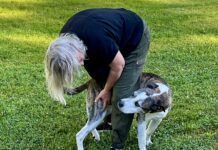In late 2022, we published a valuable article, “How to Calm an Anxious Dog: Be Predictable,” by Virginia trainer Kathy Callahan. In it, Callahan discusses how the more predictable that our dogs’ daily schedule is, the calmer their behavior is likely to be.
Dogs are incredibly quick to pick up on patterns of events that predict what we are about to do, or what we are about to make them to do. About a month ago, I re-started a habit I hadn’t practiced for a year: waking very early and taking my dogs with me for a walk around our rural “block” (about 2.5 miles). On the first and second days, they didn’t get up from their beds when I first got up at about 6 am—they likely just figured I was going to the bathroom or getting a drink of water, two events that are not worthy of leaving their beds to observe. They didn’t really pay attention to me until they heard me putting on my shoes and filling up a water bottle; then they got out of bed and stood by the door, ready to accompany me wherever I was going. By day three, they leapt up from their beds and greeted me when I sat up in bed, even before my feet had hit the floor. “Yeah! Let’s do this!” their wagging tails and eager faces seemed to say.
You may have noticed your dog getting hyped when you drive down the street that leads to their doggie daycare or their best friends’ house—or getting down on the floor of the car, cowed and shaky, when you pull into your vet’s parking lot.
Or you may have noticed that your dog howls with anticipation when you pull on your walking shoes, but pays no attention to you at all when you put on the shoes you wear to work.
People often struggle to teach their new puppies or dogs to accept short periods of confinement in a crate or pen. I find that if the confinement is regular, and not over-long nor related to the dog’s behavior (used as a punishment or “time-out”), the dog or puppy usually accepts the confinement within a matter a matter of days—like, three to four days at the very most. Once they understand that the period of their confinement is never too long and will come to an end soon, but not as a result of their howling or crying, they tend not to howl or cry, but stoically wait for their release.
Similarly, when it’s time to go for a walk, does your dog get so excited that he makes it difficult to put his harness on or snap his leash to his collar? That’s because the harness or leash always predicts a walk, and that’s exciting! But you can shape the experience so that it goes more smoothly for you, by making it entirely predictable that his hyper behavior will always circumvent a trip outdoors. If you quit the process of trying to put his harness on or dropping his leash every time he gets hyper, walking away from him for at least 10 or more minutes, it won’t take him long to put it together that he’s not going to get to go outdoors unless he holds still.
Set a pattern that works for you, and don’t deviate from it! You’ll be amazed at how well it works for you and your dog!






I LOVE your writing so much.
Here is an example: By day three, they leapt up from their beds and greeted me when I sat up in bed, even before my feet had hit the floor. “Yeah! Let’s do this!” their wagging tails and eager faces seemed to say.
As a dog owner, your writing resonates deeply with me because you are always thinking about what your dogs are thinking. And so am I. THANK YOU for all the wonderful articles and for being so articulate. You make my membership to WDJ so worth it!